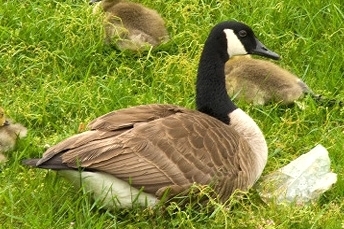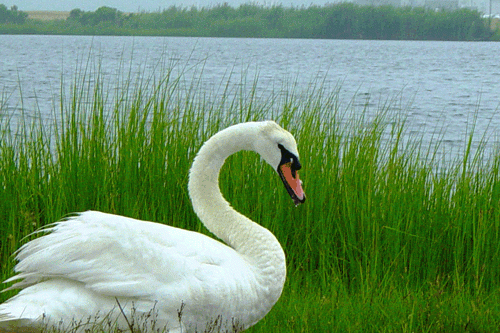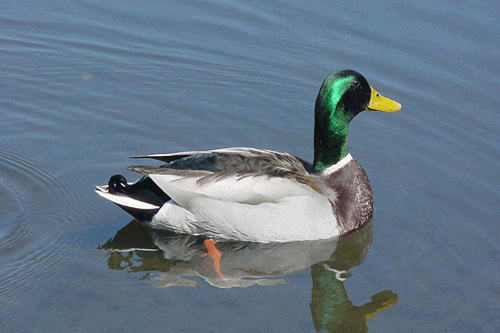Operational Activities: Waterfowl
Waterfowl are federally-protected migratory birds that are valuable natural resources enjoyed by birdwatcher's and the general public. Integrated solutions to address problems may include habitat manipulation, dispersal techniques, and population management.
Biology and Ecology
Understanding Wildlife, Damage, and Management
Although most people find a few birds acceptable, problems quickly develop as bird numbers increase. These problems include overgrazing of grass and ornamental plants; accumulation of droppings and feathers; attacks on humans by aggressive birds; and the fouling of reservoirs, swimming areas, beaches, docks, lawns, and golf courses. Flocks of geese and other waterfowl also feed on a variety of crops, including corn, soybeans, rice, lettuce, winter wheat, barley, and rye.
Damage to Property
Canada goose nests occur near sidewalks and entryways of homes and other buildings, adjacent to paths and roadways, and on rooftops and porches. They are also found in more traditional areas, including parks and other open space. Flocks can leave behind a large amount of fecal material, especially if they routinely use the same sites. The feces can reduce the water quality of ponds and spoil the lawns of parks, golf courses, apartment complexes, and business parks. Mallards, wigeons, and coots also flock in parks and residential developments and cause similar problems.
Damage to Agriculture
Migratory waterfowl cause damage to agricultural crops in many parts of the United States. Crops are vulnerable to damage by ducks, coots, and geese through direct consumption of crops as well as trampling and fouling. Some waterfowl also cause problems at aquaculture facilities by feeding on fish fry and fingerlings.
Health and Safety Concerns
Defense of nests and young by geese and swans can result in injuries to people who approach too closely. Populations of waterfowl may contaminate recreational areas with pathogenic bacteria that may pose human-health risks. Waterfowl on or near airports affect public safety due to the possibility of bird-aircraft collisions.
Damage to Natural Resources
Canada goose and mute swans may impact native wild rice, restored wetlands, and tidal marshes when large flocks graze on vegetation and trample plantings. Resident Canada goose and non-native Mute Swans may out-compete native waterbirds and waterfowl for habitat and food. Resident Canada goose and non-native Mute Swans may out-compete native waterbirds and waterfowl for habitat and food. Additionally, overabundance of ducks, geese and swans in natural areas may cause erosion and reduce water quality due to feces and runoff.
The U.S. Fish and Wildlife Service has adopted new rules for managing resident Canada geese including a nest and egg depredation order for resident Canada geese that authorizes private landowners, public land managers, homeowners' associations, and local governments to destroy resident Canada goose nest and eggs on property under their jurisdiction when necessary to resolve or prevent injury to people, property, agricultural crops, or other interests.
A Migratory Bird Depredation permit or other authorization must be obtained from the U.S. Fish and Wildlife Service (FWS), and State laws must be consulted and adhered to, prior to initiating actions to remove waterfowl or handle their nests and eggs.
- Migratory Bird Depredation Permit Application
- FWS permits and the Federal laws and Treaties that relate to migratory birds.
Resident Canada Goose Regulations
The Canada Goose Nest and Egg Depredation Order (50 CFR 21.162) authorizes landowners and local governments who register with the FWS to destroy resident Canada goose nests and eggs on their property from March 1-June 30, when necessary, to resolve or prevent injury to people, property, agricultural crops, or other interests. In order to conduct these activities, landowners must register online anytime between January 1 and June 30 of the year in which the activity will take place.
- Canada Goose Nest and Egg Depredation Order
- Registration information.
- Oiling Goose Eggs (video)
- Egg and Nest Treatment
50 CFR 21.159 - Control Order for Resident Canada Geese at Airports and Military Airbases
Managers of commercial, public, and private airports and military air operation facilities acting under authority of 50 CFR § 21.159 may take Canada geese (including nests and eggs) from on or within 3 miles of the airport or airfield boundaries, without a Federal permit.
50 CFR 21.165 - Depredation Order for Resident Canada Geese at Agricultural Facilities
Agricultural producers acting under authority of 50 CFR § 21.165 may take Canada geese from lands that they personally control and where geese are committing damage to agricultural crops, without a Federal permit.
50 CFR 21.168 - Public Health Control Order for Resident Canada Geese
States, Tribes, and the District of Columbia, via the State or Tribal wildlife agency, are authorized to take Canada geese without a Federal permit, wherever a Federal, State or local public health agency has determined that Canada geese pose a specific, immediate human health threat by creating conditions conducive to the transmission of human or zoonotic pathogens.
Wildlife Services provides technical assistance and direct management for waterfowl conflicts and facilitates the depredation permit process through WS State Offices.
- Learn more about Canada goose nest management methods.
To contact your WS State Office, call 1-866-4USDAWS (1-866-487-3297).
Wildlife Services' National Wildlife Research Center conducts research and investigation activities on a wide variety of wildlife damage issues including the effectiveness of management tools for geese.
- Effectiveness of a Motion-activated Laser Hazing System for Repelling Captive Canada Geese
- Lasers as Nonlethal Avian Repellents
Publications from other agencies, groups, and individuals
- Attitudes of Central Missouri Residents Toward Local Giant Canada Geese and Management Alternatives
- Evaluation of Canada Goose Sterilization for Population Control
- An Evaluation of Two Hazing Methods for Urban Canada Geese
- Evaluation of Three Damage Abatement Techniques for Canada Geese
- Nuisance Canada Goose Problems in the Eastern United States




